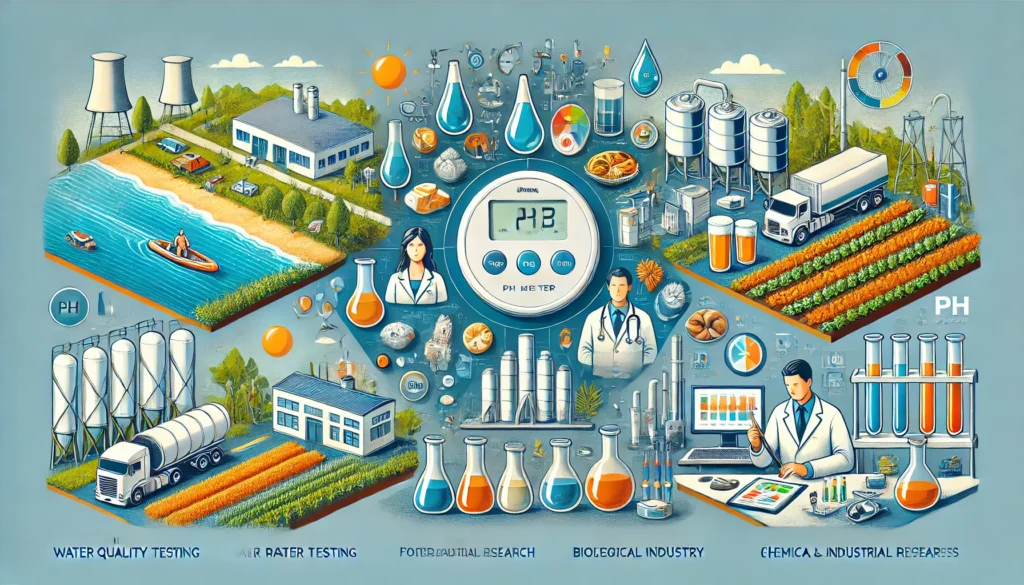
PH-METER
INTRODUCTION
TYPES
USES
Introduction to pH Meters
A pH meter is an essential scientific instrument used to measure the acidity or alkalinity of a solution, expressed as a pH value. The term “pH” stands for “potential of hydrogen,” indicating the concentration of hydrogen ions in a given solution. pH values range from 0 to 14, where 7 represents neutrality, values below 7 indicate acidity, and values above 7 denote alkalinity.
Modern pH meters provide precise and quick readings, making them invaluable in various fields, including chemistry, biology, medicine, agriculture, and environmental science. These devices typically consist of a pH electrode (sensor) and an electronic meter for reading and displaying the pH value.
Types of pH Meters
pH meters come in various designs, each suited to specific applications. Below are the primary types of pH meters with detailed explanations:
1. Benchtop pH Meters
Benchtop pH meters are stationary devices often used in laboratories. They are known for their high precision, advanced features, and the ability to measure multiple parameters such as temperature, conductivity, and salinity.

Features:
- Large digital display.
- Compatibility with multiple electrodes.
- Enhanced calibration options.
Uses: These meters are ideal for academic research, industrial quality control, and environmental testing.
2. Portable pH Meters
Portable pH meters are compact and battery-operated, making them suitable for fieldwork. They are designed for durability and ease of use in various environmental conditions.

Features:
- Lightweight and robust.
- Waterproof and shock-resistant designs available.
- Simplified calibration.
Uses: Commonly used in agriculture, water testing, and environmental monitoring.
3. Pen-Type pH Meters
Pen-type pH meters are small, easy-to-use devices shaped like a pen. They are designed for quick, on-the-go pH measurements and are more affordable compared to other types.

Features:
- Compact and user-friendly.
- Limited accuracy compared to benchtop or portable models.
- Fixed or non-replaceable electrodes in some models.
Uses: Suitable for home use, aquarium maintenance, and quick field tests.
4. Online pH Meters
Online pH meters are integrated into industrial processes for real-time monitoring and control. They are designed to work continuously under varying conditions.

Features:
- Continuous monitoring capability.
- Integration with industrial control systems.
- High durability for harsh environments.
Uses: Widely used in water treatment plants, chemical manufacturing, and food processing industries.
Uses of pH Meters
pH meters have diverse uses across various domains. Some of the key uses include:
- Water Quality Testing:
- Monitoring the pH of drinking water, swimming pools, and aquariums.
- Ensuring compliance with environmental regulations for wastewater.
2. Agriculture:
- Measuring soil pH to optimize crop yield.
- Analyzing pH levels in fertilizers and irrigation water.

3. Food and Beverage Industry:
- Monitoring the pH of products like cheese, wine, and beer during production.
- Ensuring food safety and quality standards.
4. Medical and Biological Research:
- Measuring the pH of biological samples like blood and urine.
- Supporting laboratory experiments in microbiology and pharmacology.
5. Chemical and Industrial Processes:
- Controlling pH in chemical reactions.
- Monitoring pH during product manufacturing.
Applications of pH Meters
1. Environmental Monitoring
- Water Bodies: pH meters are crucial for assessing the health of lakes, rivers, and oceans. They help detect pollution levels and maintain aquatic ecosystems.
- Air Quality: Indirectly used to monitor acid rain effects by measuring the pH of affected water and soil.
2. Industrial Applications
- Chemical Production: Precise pH control is essential in synthesizing chemicals, ensuring product consistency and safety.
- Pharmaceutical Industry: pH meters assist in formulating drugs, ensuring stability and efficacy.
3. Healthcare
- Used in diagnostic labs for analyzing pH-dependent parameters in bodily fluids.
- Important for creating pH-balanced solutions for medical treatments.
4. Education and Research
- Frequently used in schools, colleges, and research institutions for experiments and studies related to chemistry and biology.
5. Household Applications
- Ensuring the proper pH of swimming pools and aquariums.
- Checking the pH of homemade skincare products and beverages.
Key Components and Working Principle of pH Meters
A typical pH meter consists of:
- Electrode (Probe): Measures the hydrogen ion activity in the solution.
- Meter: Displays the pH value based on the probe’s output.
Working Principle:
The electrode generates a small voltage proportional to the hydrogen ion concentration. This voltage is then converted into a readable pH value by the electronic meter.
Maintenance and Calibration of pH Meters
Regular maintenance and calibration are essential for accurate and reliable results. Here are some tips:
- Calibration: Use standard buffer solutions (pH 4, 7, 10) to recalibrate the device periodically.
- Cleaning: Rinse the electrode with distilled water after each use and store it in a suitable storage solution.
- Storage: Keep the electrode moist to maintain its functionality.
Conclusion
pH meters are indispensable tools across multiple industries and fields of research. Understanding their types, uses, and applications can help users select the right device and employ it effectively. Proper maintenance ensures longevity and accuracy, making these instruments a vital part of scientific and industrial advancements.